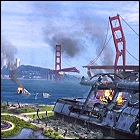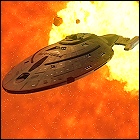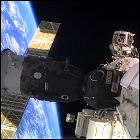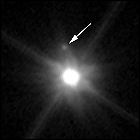Star Trek: DS9: The Changing Face Of Evil
 The week-long national syndication window opens for the 168th episode of Star Trek: Deep Space Nine. This episode continues a tightly-serialized eight-episode run-up to the series finale. Louise Fletcher guest stars.
The week-long national syndication window opens for the 168th episode of Star Trek: Deep Space Nine. This episode continues a tightly-serialized eight-episode run-up to the series finale. Louise Fletcher guest stars.
More about Star Trek: Deep Space Nine in the LogBook and theLogBook.com Store
Star Trek: Deep Space Nine now streaming on Paramount Plus

 The 41st episode of Gene Roddenberry’s Earth: Final Conflict, airs in syndication, starring Robert Leeshock, Lisa Howard, Von Flores, and Richard Chevolleau. Janet Kidder (Continuum, Star Trek: Discovery) guest stars.
The 41st episode of Gene Roddenberry’s Earth: Final Conflict, airs in syndication, starring Robert Leeshock, Lisa Howard, Von Flores, and Richard Chevolleau. Janet Kidder (Continuum, Star Trek: Discovery) guest stars. The 19th episode of Highlander: The Raven, starring Amanda Gracen and Paul Johannson, airs in syndication; the series is a spinoff from Highlander: The Series. Miles Richardson (Mindgame, Mindgame Trilogy) guest stars.
The 19th episode of Highlander: The Raven, starring Amanda Gracen and Paul Johannson, airs in syndication; the series is a spinoff from Highlander: The Series. Miles Richardson (Mindgame, Mindgame Trilogy) guest stars. UPN airs the
UPN airs the  UPN airs the
UPN airs the  The 41st episode of James Cameron & Charles H. Eglee’s cyberpunk series Dark Angel, starring Jessica Alba and Michael Weatherly, airs on Fox. Ashley Scott (Birds Of Prey, Jericho) guest stars.
The 41st episode of James Cameron & Charles H. Eglee’s cyberpunk series Dark Angel, starring Jessica Alba and Michael Weatherly, airs on Fox. Ashley Scott (Birds Of Prey, Jericho) guest stars. Pay cable channel Showtime premieres
Pay cable channel Showtime premieres  The seventh full-time crew of the International Space Station lifts off from Russia aboard Soyuz TMA-2, a drastic change from their original mission plan. Originally planned to be another short-term “ferry flight” to swap out the station’s Soyuz lifeboat vehicle, Soyuz became the only way to send full-time crews to the station during the post-Columbia-disaster grounding of the American shuttle fleet. Yuri Malenchenko and Ed Lu took up residence aboard the ISS for 184 days, returning in October 2003 with Spanish astronaut Pedro Duque. With the shuttle fleet landlocked, two-man ISS crews became the norm, as three-man crews relied on the greater resupply capacity of the shuttles.
The seventh full-time crew of the International Space Station lifts off from Russia aboard Soyuz TMA-2, a drastic change from their original mission plan. Originally planned to be another short-term “ferry flight” to swap out the station’s Soyuz lifeboat vehicle, Soyuz became the only way to send full-time crews to the station during the post-Columbia-disaster grounding of the American shuttle fleet. Yuri Malenchenko and Ed Lu took up residence aboard the ISS for 184 days, returning in October 2003 with Spanish astronaut Pedro Duque. With the shuttle fleet landlocked, two-man ISS crews became the norm, as three-man crews relied on the greater resupply capacity of the shuttles.
 Astronomers reveal that Makemake, an icy dwarf planet orbiting in the distant Kuiper Belt region of the solar system, has a moon, first spotted in 2015 by a team using the Hubble Space Telescope. (The news comes just days after the 26th anniversary of Hubble’s launch.) With an estimated diameter of 100 miles (compared to the 870 mile diameter of its parent body), the satellite orbits Makemake at a distance of 13,000 miles, taking twelve days to complete one orbit. Previous observations failed to pick up on the dark, dim body due to the relatively bright glare of Makemake itself.
Astronomers reveal that Makemake, an icy dwarf planet orbiting in the distant Kuiper Belt region of the solar system, has a moon, first spotted in 2015 by a team using the Hubble Space Telescope. (The news comes just days after the 26th anniversary of Hubble’s launch.) With an estimated diameter of 100 miles (compared to the 870 mile diameter of its parent body), the satellite orbits Makemake at a distance of 13,000 miles, taking twelve days to complete one orbit. Previous observations failed to pick up on the dark, dim body due to the relatively bright glare of Makemake itself.  The 42nd episode of The Flash, a modern-day reboot of DC Comics’ superhero starring Grant Gustin, airs on the CW.
The 42nd episode of The Flash, a modern-day reboot of DC Comics’ superhero starring Grant Gustin, airs on the CW. The 111th episode of Arrow, a modern-day reboot of DC Comics’ Green Arrow superhero starring Stephen Amell, airs on the CW.
The 111th episode of Arrow, a modern-day reboot of DC Comics’ Green Arrow superhero starring Stephen Amell, airs on the CW. The CW airs the 17th episode of Batwoman, starring Ruby Rose and Rachel Skarsten. Alex Zahara (Babylon 5: Legend Of The Rangers, Jeremiah) guest stars.
The CW airs the 17th episode of Batwoman, starring Ruby Rose and Rachel Skarsten. Alex Zahara (Babylon 5: Legend Of The Rangers, Jeremiah) guest stars. The CW airs the 25th episode of Superman & Lois, starring Tyler Hoechlin, Elizabeth Tulloch, Jordan Elsass, and Alex Garfin.
The CW airs the 25th episode of Superman & Lois, starring Tyler Hoechlin, Elizabeth Tulloch, Jordan Elsass, and Alex Garfin.